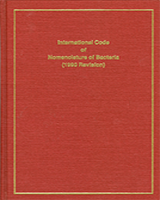Principles (original) (raw)
NCBI Bookshelf. A service of the National Library of Medicine, National Institutes of Health.
Lapage SP, Sneath PHA, Lessel EF, et al., editors. International Code of Nomenclature of Bacteria: Bacteriological Code, 1990 Revision. Washington (DC): ASM Press; 1992.
International Code of Nomenclature of Bacteria: Bacteriological Code, 1990 Revision.
Chapter 2Principles
Principle 1
The essential points in nomenclature are as follows.
- Aim at stability of names.
- Avoid or reject the use of names which may cause error or confusion.
- Avoid the useless creation of names.
Note. "Name" in this Code is used to refer to scientific names applied to bacteria (see Chapter 3, Section 3).
Principle 2
The nomenclature of bacteria is independent of botanical nomenclature, except for algae and fungi, and of zoological nomenclature, except protozoa. For these exceptions and for relationships with virological nomenclature, see General Consideration 5 and Rule 51b(4).
"Independent" means that the same name may be validly used for a taxon of bacteria as well as a taxon of plants or animals with the exceptions noted above.
Principle 3
The scientific names of all taxa are Latin or latinized words treated as Latin regardless of their origin. They are usually taken from Latin or Greek (see Chapter 3, Section 9, and Appendix 9).
Principle 4
The primary purpose of giving a name to a taxon is to supply a means of referring to it rather than to indicate the characters or the history of the taxon.
Principle 5
The application of the names of taxa is determined by means of nomenclatural types, referred to in this Code as types (see Chapter 3, Section 4).
Principle 6
The correct name of a taxon is based upon valid publication, legitimacy, and priority of publication (see Chapter 3, Section 5).
Principle 7
A name of a taxon has no status under the rules and no claim to recognition unless it is validly published (see Chapter 3, Section 5B).
Principle 8
Each order or taxon of a lower rank with a given circumscription, position, and rank can bear only one correct name, i.e., the earliest that is in accordance with the Rules of this Code. Provision has been made for exceptions to this Principle (see Rules 23a and 23b and the Statutes of the ICSB).
Note 1. The name of a species is a binary combination of generic name and specific epithet.
Note 2. (i) By circumscription is meant an indication of the limits of a taxon, (ii) by position is meant the higher taxon in which a taxon is placed when there may be alternatives (see also Rule 23a), and (iii) by rank is meant level in the hierarchial sequence of taxonomic categories.
Principle 9
The name of a taxon should not be changed without sufficient reason based either on further taxonomic studies or on the necessity of giving up a nomenclature that is contrary to the Rules of this Code.
Copyright © 1992, International Union of Microbiological Societies.
Bookshelf ID: NBK8807
